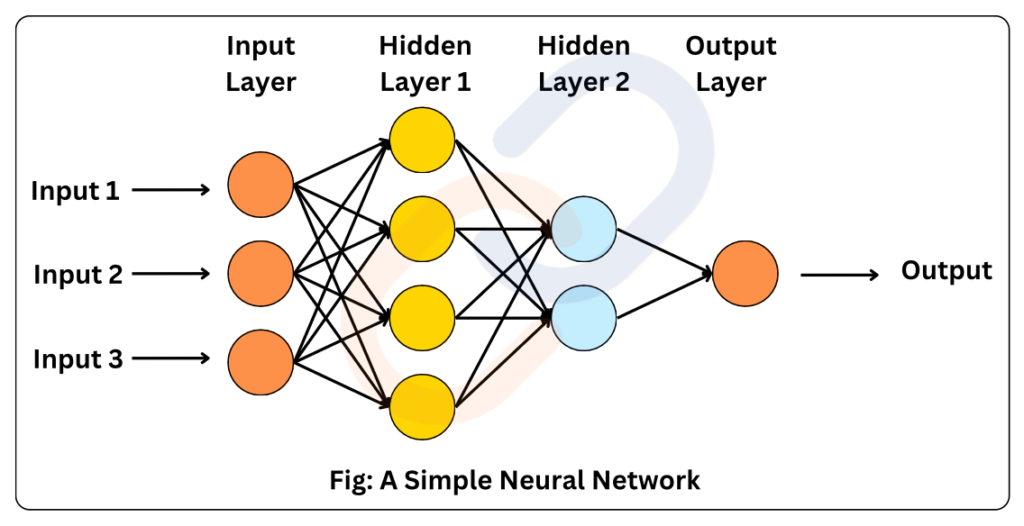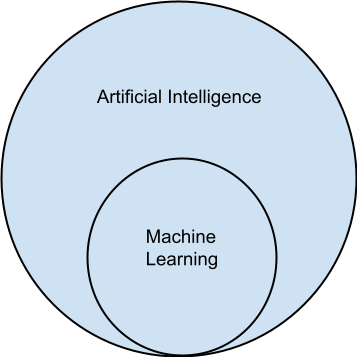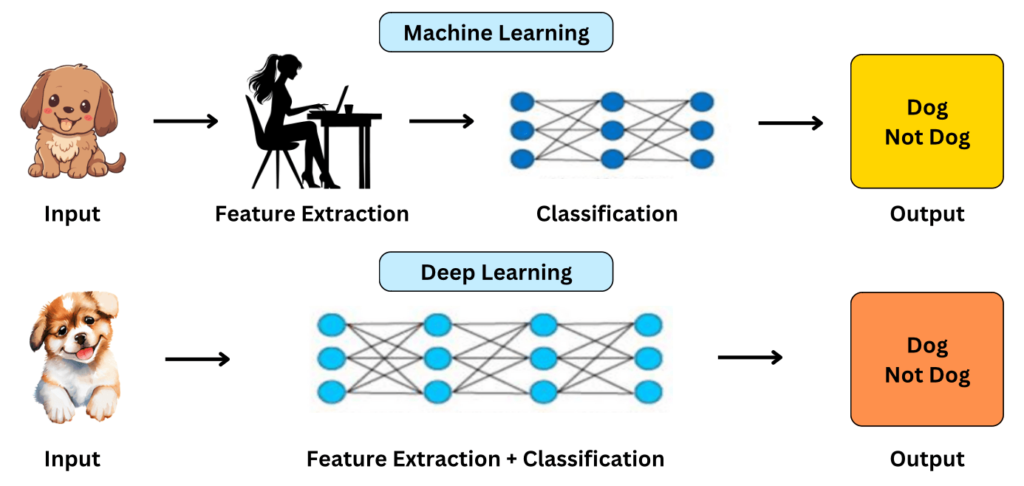Recent Developments in Information and Communication Technology In the subject Technology, the topic Recent Developments in Information and Communication Technology highlights the rapid progress in digital tools and communication systems. Innovations like 5G, artificial intelligence, and cloud computing are transforming how we connect, work, and share information globally.
Previous year Questions
| Year | Question | Marks |
| 2023 | What is the full form of AIRAWAT ? Write its any four infrastructure requirements. 5MDescribe in brief about ChatGPT. (2.5 M) What is a neural network in the context of Artificial Intelligence ? 2.5M | 10M |
| 2021 | What is an OTT platform? | 2M |
| 2021 | What is the basic concept of RFID? Give two applications of this technology. | 2M |
| 2021 | What is Cryptocurrency? What are its advantages and disadvantages? | 2M |
| 2013 | What is Cyber Warfare ? How is this technique used in war ? | 2M |
Information and Communication Technology
Deep Learning and Neural Networks
Deep Learning inspired by the human brain and its neurons.
- It is a branch of Machine Learning that relies on Artificial Neural Networks (ANN), mimicking the human brain.
- Unlike traditional programming, Deep Learning doesn’t require explicit programming for every task.
Artificial Neural Networks (ANN)
- Deep Learning uses Artificial Neural Networks (ANN), which are inspired by the structure and function of the human brain.
- ANNs are layers of software units (neurons) that process data by passing it through multiple layers.
The structure typically includes:
- Input Node: Takes real-world data and feeds it into the network.
- Hidden Node: Processes and computes the data (may have multiple layers).
- Output Node: Produces the final result and connects back to the real world.

This layered approach allows machines to learn from data, enabling tasks like classification and prediction. In summary, an ANN works by passing data from one neuron to another in layers, transforming it until it reaches a conclusion or output. This process is similar to how our brain makes decisions based on connections between neurons.
Connections:
- Weights: Connections between neurons have weights that are adjusted during training to minimize errors.
- Biases: Additional parameters added to the inputs to the neurons to help with the model’s flexibility.
Training Neural Networks:
- Learning Process: Involves adjusting the weights and biases to minimize the difference between the predicted and actual outputs.
- Backpropagation: A common algorithm used to update weights by propagating the error backward through the network.
Examples of Deep Learning/Neural Network
- Automated Driving: Detects stop lights, traffic signals, and pedestrians to prevent accidents.
- Image and Speech Recognition: Used in facial recognition systems, voice assistants, and more.
- Natural Language Processing: Powers chatbots, language translation, and sentiment analysis.
- Predictive Analytics: Used in finance, healthcare, and marketing for forecasting and decision-making.
- Aerospace and Defence: Identifies objects from satellite images to locate safe or unsafe zones for troops.
- Medical Research: Assists in detecting cancer cells automatically, aiding in early diagnosis.
- Industrial Automation: Improves worker safety by detecting people or objects near dangerous machinery.
Machine Learning
Definition:
- “Machine learning is the science of getting computers to act without being explicitly programmed.” – Stanford University
- Machine Learning (ML) is a subset of artificial intelligence (AI) that enables systems to learn from data, identify patterns, and make decisions without being explicitly programmed.
- Examples:
- Gmail automatically classifying emails as ‘Spam’ and ‘Not Spam;
- Flipkart or Amazon recommending you to buy products of your choice.
Why Machine Learning?

- Automation: Automates the process of analytical model building.
- Data Utilization: Extracts insights from vast amounts of data.
- Adaptability: Improves over time with new data, becoming more accurate and efficient.
- Efficiency and Productivity: Reduces time, effort, and errors in decision-making
- Solving Complex Problems: Climate modeling, financial fraud detection, and scientific research.
- Widespread Applications: Personalized recommendations (Netflix, Amazon); Autonomous technologies (self-driving cars, drones).
Key Concepts in Machine Learning
- Data: The foundation of ML. Machines learn from structured or unstructured datasets.
- Structured Data: Organized data like spreadsheets.
- Unstructured Data: Data like images, text, or videos.
- Features and Labels:
- Features: Input variables or attributes (e.g., temperature, size).
- Labels: Output or target variable (e.g., rainy, sunny for weather prediction).
- Learning Process:
- Training: Feeding data into the ML algorithm to build a model.
- Testing: Evaluating the model’s performance on new data.
Machine Learning Application
- Speech Recognition: Eg- Siri, Alexa, etc
- Customer Service: Eg- Slush, Maya Chatbots, etc.
- Computer Vision: Eg- Google Translate, Facebook 3D Photo, Faceapp, etc.
- Recommendation Engines: Eg- online ads, Spotify for recommending songs, etc.
- Automated Stock Trading: Eg- NinjaTrader, etc.
- Fraud Detection: Eg- Credit card fraud detection, POS fraud detection, etc.
Machine Learning involves three key components:
- Decision Process: The model makes predictions based on input data, learning patterns from labeled examples (supervised learning).
- Error Function: It measures how far predictions are from actual values, helping evaluate the model’s performance.
- Model Optimization: The model adjusts its parameters to minimize the error, typically using techniques like gradient descent, improving its accuracy over time.
Difference between AI, ML, and Deep Learning
| Aspect | Artificial Intelligence (AI) | Machine Learning (ML) | Deep Learning (DL) |
| Definition | AI simulates human intelligence to perform tasks and make decisions. | ML is a subset of AI that uses algorithms to learn patterns from data. | DL is a subset of ML that uses artificial neural networks for complex tasks. |
| Learning Approach | Can use predefined rules or logic to simulate intelligence. | Relies on algorithms to learn from labeled or unlabeled data. | Automates feature extraction using deep neural networks. |
| Data Dependency | May or may not require large datasets; can use predefined rules. | Heavily relies on structured, labeled data for training. | Requires extensive data and performs best with large datasets. |
| Complexity | Includes rule-based systems, natural language processing, robotics, and more. | Focuses on specific data-driven tasks like classification or prediction. | Handles highly complex tasks like image recognition, NLP, and autonomous systems. |
| Training Requirements | May require less training for rule-based systems. | Training time depends on data size and algorithm complexity. | Requires substantial computational resources and time. |
| Applications | Virtual assistants, robotics, automated reasoning, etc. | Spam detection, price prediction, recommendation systems. | Self-driving cars, speech recognition, image analysis. |

Types of Machine Learning
Machine learning is divided into three main types:
Supervised Learning
- Definition: In supervised learning, the machine learns from labeled data (data that has both inputs and known outputs). The machine uses this data to find patterns and make predictions for new, unseen data.
- Example: Teaching a computer to identify cats in photos (each photo is labeled “cat” or “not cat”).
- Models: Linear Regression, Logistic Regression, Support Vector Machines (SVM), Decision Trees, K-Nearest Neighbors (KNN)
- Applications:
- Spam detection (is this email spam or not?)
- Price prediction (predict house prices from features like size and location).
- ICAR and agri-tech startups like CropIn use supervised learning to predict crop production based on weather, soil, and farming practices.
- Banks like HDFC and SBI analyze historical loan repayment data to classify applicants as eligible or ineligible.
Unsupervised Learning
- Definition: Unsupervised learning uses unlabeled data (data without known outcomes). The machine tries to find hidden patterns or groupings in the data on its own.
- Example: Grouping shopping items by similarity (e.g., grouping fruits and vegetables together without labels).
- Models: K-Means Clustering, Hierarchical Clustering, Principal Component Analysis (PCA), Autoencoders etc.
- Applications:
- Customer segmentation (grouping customers by buying habits).
- Anomaly detection (finding unusual data points, like fraud in transactions).
- Government schemes like PMGSY (rural road connectivity) use clustering to identify underdeveloped areas for resource allocation.
Reinforcement Learning
- Definition: In reinforcement learning, an agent (machine) learns by interacting with its environment and receiving rewards or penalties for its actions. The goal is to maximize the cumulative reward over time through trial and error.
- Example: A robot learning to navigate a room (it gets a reward for moving correctly, and a penalty for bumping into walls)
- Models: Q-Learning, Deep Q-Network (DQN), Policy Gradient Methods, Proximal Policy Optimization (PPO).
- Applications:
- Game playing (e.g., teaching a computer to play chess).
- Self-driving cars (learning to drive by receiving rewards for safe driving).
Traditional Programming vs. Machine Learning
Conventional programming and ML coding both are computer programs but their approach and objective are different.
| Aspect | Machine Learning | Traditional Programming |
| Process | Input data and the output data are fed to an algorithm (Machine learning algorithm) to create a program. | Refers to any manually created program which uses input data, runs on a computer and produces the output. |
| Data-driven approach | Learn from data to adapt and improve over time. | Relies on predefined rules and logic. |
| Generalization | Generalizes patterns to make predictions on new, unseen data. | Creates specific rules for each scenario. |
| Automation | Automates learning and decision-making processes based on data. | Requires manual updates to rules and logic. |
| Scalability | Can handle large and complex datasets effectively. | May struggle to scale for large data volumes. |
| Iterative improvement | Models can be trained iteratively to refine performance over time. | Code is rarely updated unless necessary. |
Applications of Machine Learning
Healthcare
- Disease Diagnosis: ML algorithms analyze medical images (X-rays, MRIs, CT scans) for conditions like cancer or fractures.
Technology : Convolutional Neural Networks (CNNs) for image recognition. - Personalized Medicine: ML analyzes patient data to recommend treatments tailored to individuals.
- Predictive Healthcare: ML predicts disease outbreaks or patient readmission risks.
Technology : Decision Trees and Random Forests for classification. - Example: Niramai (AI-based breast cancer detection), Doc.ai (AI healthcare assistant)
Finance
- Fraud Detection: ML models identify unusual transactions or patterns signaling fraud. Technology : Anomaly detection and supervised learning models.
- Algorithmic Trading: Financial institutions use ML to predict market trends for automated trading.
Technology: Time series analysis and neural networks. - Credit Scoring: ML helps assess loan applicants’ creditworthiness by analyzing past financial data.
Technology: Logistic Regression and Decision Trees. - Example: CreditVidya (AI-based credit scoring)
E-Commerce and Retail
- Recommendation Systems: Online platforms (Amazon, Netflix, Spotify) use ML to suggest products, movies, or music.
Technology: Collaborative filtering and matrix factorization. - Demand Forecasting: Retailers use ML to predict future product demand and optimize inventory. Technology: Regression models, time series forecasting, and neural networks.
- Customer Service Automation: Chatbots powered by ML assist with customer queries.
Technology: NLP models like transformers and RNNs. - Example: Flipkart (Product recommendation system)
Transportation
- Self-Driving Cars: ML enables autonomous vehicles to recognize objects, plan routes, and navigate.
Technology: CNNs for image recognition, reinforcement learning for decision-making. - Traffic Prediction and Management: ML analyzes traffic patterns to optimize routes and reduce congestion.
Technology: Time series forecasting and reinforcement learning.
Natural Language Processing (NLP)
- Speech Recognition: ML enables virtual assistants like Siri and Google Assistant to understand spoken language.
Technology: RNNs and LSTMs for speech-to-text conversion. - Text Analysis: Analyzing text for sentiment analysis, summarization, and spam filtering.
Technology: BERT, GPT, and Word2Vec models. - Translation Services: ML translates text between languages (e.g., Google Translate).
Technology: Sequence-to-sequence models and transformers. - Example: Bhashini (AI for language translation)
Manufacturing and Industry 4.0
- Quality Control: ML inspects production lines to detect defects or quality issues.
Technology: CNNs for computer vision. - Supply Chain Optimization: ML forecasts supply and demand, optimizes warehouse operations, and manages logistics.
Technology: Time series forecasting and optimization algorithms.
Agriculture
- Precision Farming: ML optimizes irrigation, fertilization, and pest control based on satellite and sensor data.
- Livestock Monitoring: ML tracks animal health, movement, and feeding patterns.
- Example: Startup AgNext (AI for agriculture), CropIn (Smart farming platform)
Cybersecurity
- Threat Detection: ML detects anomalies in network traffic to identify cyber threats.
- Authentication Systems: Facial recognition and biometric systems provide secure access controls.
Technology: CNNs for facial feature recognition.
Entertainment and Media
- Content Personalization: Streaming services like Netflix use ML to personalize recommendations.
Technology: Collaborative filtering, reinforcement learning, and matrix factorization. - Video Games: ML creates adaptive non-playable characters (NPCs) that evolve based on player actions.
Technology: Reinforcement learning for NPC behavior learning.
Smart Cities
- Machine learning is used in smart cities to improve urban planning, optimize traffic flow, enhance public safety, and manage utilities efficiently.
- Bengaluru (Traffic management using ML)
- Surat (Waste management using AI
Ethics and Challenges in Machine Learning
| Ethics in Machine Learning | Challenges in Machine Learning |
| Bias and Fairness: * Models can amplify biases from data, leading to unfair outcomes. * Example: Discrimination in hiring algorithms or loan approvals. Privacy Concerns: * Using personal data without consent violates privacy rights. * Example: Monitoring user behavior or facial recognition without permission. Transparency and Explainability: * Many models, especially deep learning, act as “black boxes.” * Lack of clarity on how decisions are made creates trust issues. Accountability: * Difficult to determine who is responsible for errors in ML-driven systems. * Example: Liability for accidents caused by autonomous vehicles. Job Displacement: * Automation through ML could replace human jobs in various sectors. Technological Singularity: * The possibility of machines surpassing human intelligence raises ethical concerns. | Data Issues: * Quality: Inconsistent, noisy, or biased data impacts model accuracy. * Quantity: Insufficient data leads to poor model training. Overfitting and Underfitting: * Overfitting: Model performs too well on training data but poorly on unseen data. * Underfitting: Model fails to capture patterns in the data. Transparency: * Many models, like deep learning, are “black boxes.” → Lack of explainability in decision-making. Scalability: * Handling large datasets and deploying ML models efficiently can be resource-intensive. Evolving Data: * Models need to adapt to new patterns in dynamic datasets. Computational Costs: * High computational resources and energy consumption are needed for training large models. |
Recent Indian Initiatives
- Machine Learning for Predicting Crustal Movements in the Tibetan Plateau
- ISRO’s Use of AI & ML in Space Domain
- Focus areas include launch vehicles, spacecraft operations, big data analytics, space robotics, and space traffic management.
- AI & ML-Based Trademark Search Technology and IP Saarthi Chatbot Launched
- The technology aims to accelerate and improve the accuracy of trademark application clearance, resolving conflicts, and enhancing patent disposals.
- IP Saarthi Chatbot: A digital assistant offering instant guidance through the intellectual property (IP) registration process.
- Government’s Vision: In line with Prime Minister Modi’s vision of “Intelligence, Idea, and Innovation,” the government aims to make India a developed nation by 2047, with AI as a key tool for progress.
- Renewable Energy Efficiency Tool: Researchers at IIT Madras have developed a machine learning tool to predict the performance of solar panels, aiming to improve renewable energy efficiency.
